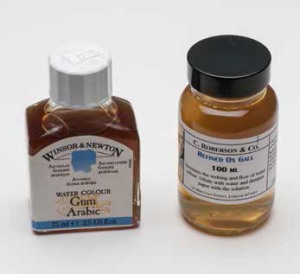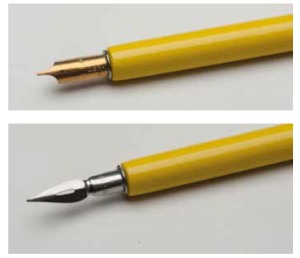articles/Printing/Making-Your-Mark-page5
Making Your Mark - part 5 of 1 2 3 4 5 6 7 8 9 10
by Mike McNamee Published 01/06/2015

Uppers and Downers
We anticipated trouble with some of the ink formulations we intended to try. To this end, we purchased both Gum Arabic and Ox Gall ahead of testing. Gum Arabic is used to thicken an ink and restrict its flow; Ox Gall is added to ink in very small quantities (a drop in a whole bottle) and promotes both wetting and flow. Ox Gall has the reputation of making anything stick to anything else (and is traditionally used when applying ink to vellum) - but you would need to experiment.

Pens and Nibs
The choice of ink and nib (together) is crucial to success. Nibs are complex things. They were made in vast numbers in Birmingham and the designs were refined there for 130 years or more. The Jewellery District of Birmingham once used to make about 75% of the world's nibs and pens, delivering 10 million of them in 1930. The wonderful old buildings still exist and are being converted to housing today.
The plain dip pen nibs we tried were a Brandauer, gold-plated No1 F, a lacquered Hinks Wells No2 M and a Hinks Wells, Rob Roy 2687M-Stainless Steel. As far as we can tell by eye, the two Hinks Wells are the same design. All carry the crown logo of the Stationery Office (later to become HMSO) and are probably at least half a century old. We had a plastic pen holder of the same vintage but found it too thin for comfortable use and swapped to a more modern design.
The Brandauer nibs worked well with FS Chrome, and had much more character because it was a straight tip rather than the round-hand shape of the Hinks Wells. Both are masterpieces of nib craftsmanship (see callout), but the Hinks Wells flooded the page with FS Ink (see below).
Please Note:
There is more than one page for this Article.
You are currently on page 5
- Making Your Mark page 1
- Making Your Mark page 2
- Making Your Mark page 3
- Making Your Mark page 4
- Making Your Mark page 5
- Making Your Mark page 6
- Making Your Mark page 7
- Making Your Mark page 8
- Making Your Mark page 9
- Making Your Mark page 10
1st Published 01/06/2015
last update 09/12/2022 14:56:21
More Printing Articles
There are 20 days to get ready for The Society of Photographers Convention and Trade Show at The Novotel London West, Hammersmith ...
which starts on Wednesday 14th January 2026





